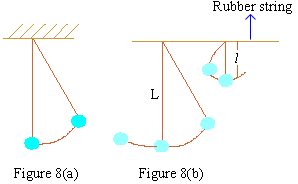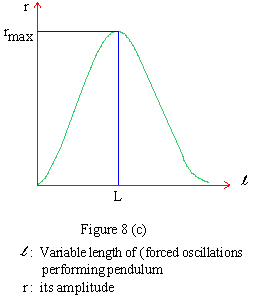|
10.6 Forced Oscillations and Resonance  The concept of forced oscillations can be explained with an example of a simple pendulum suspended from rigid support as in Fig 8(a) and two pendulums suspended side by side from a rubber string as in Fig 8(b). The concept of forced oscillations can be explained with an example of a simple pendulum suspended from a rigid support as in Fig 8(a) and two pendulums suspended side by side from a rubber string as in Fig 8(b) The Oscillations of pendulum of length L in Fig. 8(a) are called free oscillations. Similarly oscillations of pendulum of fixed length L in Fig 8(b) are also called free oscillations. The pendulum of length 'l' (variable) due to free oscillations of pendulum of length L are called forced oscillations. The forced oscillations are communicated through a medium (Rubber String in this example); but non- mechanical waves such as Electro- Magnetic waves can be communicated through empty space as well as through the electro-magnetic field. The response of pendulum of length 'l' in terms of its amplitude compared with fixed amplitude of the freely oscillating pendulum varies with the length 'l' and it is found that the pendulumperforming forced oscillationsoscillateswith maximumamplitudewhenits lengthismadeequal to L, see fig: 8(c) below.  At l = L, i.e, when frequency (natural ) 'n' of pendulum of length 'l' is forced upon it by pendulum of length 'L' then the first pendulum has maximum amplitude of forced oscillations; and since energy of oscillations is proportional to r2 , therefore maximum energy is absorbed when l = L from the same constant supply of energy by freely oscillating pendulum. The phenomenon of maximum absorption of energy by forced system is called resonance phenomenon. The maximum absorption of energy by forced system when its natural frequency is forced on it is the phenomenon of resonance.
The Phenomenon of resonance in the basic principle in
********** |
10.1 Intensity and Pitch Follow @Pinkmonkey_com  |
